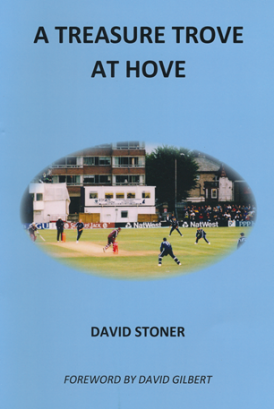A Treasure Trove At Hove
Martin Chandler |Published: 2021
Pages: 92
Author: Stoner, David
Publisher: Sussex Cricket Museum
Rating: 3.5 stars

Something I learnt on joining the legal profession, many more years ago than I care to remember, was that it is generally unwise to make sweeping assumptions. By and large that is a lesson that I have always carried with me although, just occasionally, I have let myself down by doing so.
The Sussex Cricket Museum is a good example of an instance of my allowing myself to be seduced into presuming wrongly. It was back in 2011 that I was one of the first in the queue to acquire one of their excellent limited edition publications, of which there have now been upwards of thirty issued, a goodly number of which we have reviewed*.
Where I went wrong was assuming that the publication of that first booklet marked the creation of the Museum, and that accordingly the Museum itself had just reached double figures this year. That booklet was on the subject of AJ Gaston, a writer, historian and book dealer of a century ago. The focus of the booklet, which bore Gaston’s name as its title, was the reproduction of three very rare benefit souvenirs produced before the Great War for Sussex stars of the Golden Age.
Not unnaturally in the circumstances I was expecting David Stoner’s booklet, which I already knew to be a history of the Museum, to be a strictly twenty first century affair, and that is where I relearnt the old lesson. In fact the Museum can trace its ancestry back to 1948 and presumably the acquisition of artefacts even further. It is only the current incarnation, a registered charity, that is a recent creation.
A Treasure Trove At Hove has been written by David Stoner, a retired chartered accountant. His was not a name I immediately recognised, but his role as life member, vice president and treasurer of the club in the early years of this century saw him play a crucial role in the creation of the independent Museum.
The Museum’s roots lie in a library, and whilst it may not on its face seem a particularly interesting subject the history and development of that resource is the story that Stoner tells. Skilfully wrapping that up with aspects of how the county club has been run and administered, and featuring a number of digressions it is however a most entertaining read.
Younger readers will be surprised at the struggle women had in the 1970s to even become eligible for a place on the county’s committee, and it is unfortunate that the law of defamation does not allow Stoner to give more detail about the circumstances of a less than successful auction of some of the club’s artefacts that took place in 1980.
Funding has, naturally, been a problem over the years and the library/museum’s fortunes in that respect, and where it was accommodated, has waxed and waned. Money was was a constant source of problems for the club until a very substantial inheritance came the way of Sussex after the death of Spen Cama in 2001. Part of that story is recounted as well although, on the face of matters somewhat perversely, the years that followed were not the happiest for the library.
A Treasure Trove At Hove does of course have a happy ending, and whilst it may not be of wide appeal, to anyone with an interest in cricket books and memorabilia it is certainly worth its price tag, especially as all proceeds go to such an excellent cause. The booklet is available through the Museum’s website.






This very interesting publication will be of particular interest to those concerned with preserving county cricket’s heritage. The decision to move management and ownership of the assets to a trust was a bold one (for the county club as well as the trustees), and it remains important to maintain good relations between the trust and the county club, which appears to have been achieved.
Comment by Christopher O’Brien | 10:07am BST 17 October 2021